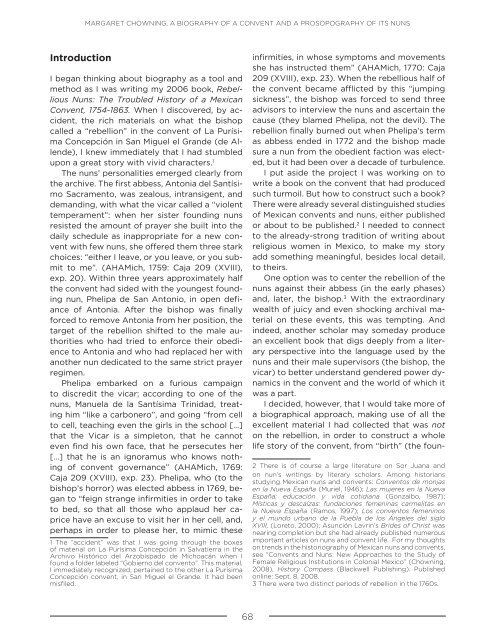Create successful ePaper yourself
Turn your PDF publications into a flip-book with our unique Google optimized e-Paper software.
MARGARET CHOWNING, A BIOGRAPHY OF A CONVENT AND A PROSOPOGRAPHY OF ITS NUNS<br />
Introduction<br />
I began thinking about biography as a tool and<br />
method as I was writing my 2006 book, Rebellious<br />
Nuns: The Troubled History of a Mexican<br />
Convent, 1754-1863. When I discovered, by accident,<br />
the rich materials on what the bishop<br />
called a “rebellion” in the convent of La Purísima<br />
Concepción in San Miguel el Grande (de Allende),<br />
I knew immediately that I had stumbled<br />
upon a great story with vivid characters. 1<br />
The nuns’ personalities emerged clearly from<br />
the archive. The first abbess, Antonia del Santísimo<br />
Sacramento, was zealous, intransigent, and<br />
demanding, with what the vicar called a “violent<br />
temperament”: when her sister founding nuns<br />
resisted the amount of prayer she built into the<br />
daily schedule as inappropriate for a new convent<br />
with few nuns, she offered them three stark<br />
choices: “either I leave, or you leave, or you submit<br />
to me”. (AHAMich, 1759: Caja 209 (XVIII),<br />
exp. 20). Within three years approximately half<br />
the convent had sided with the youngest founding<br />
nun, Phelipa de San Antonio, in open defiance<br />
of Antonia. After the bishop was finally<br />
forced to remove Antonia from her position, the<br />
target of the rebellion shifted to the male authorities<br />
who had tried to enforce their obedience<br />
to Antonia and who had replaced her with<br />
another nun dedicated to the same strict prayer<br />
regimen.<br />
Phelipa embarked on a furious campaign<br />
to discredit the vicar; according to one of the<br />
nuns, Manuela de la Santísima Trinidad, treating<br />
him “like a carbonero”, and going “from cell<br />
to cell, teaching even the girls in the school […]<br />
that the Vicar is a simpleton, that he cannot<br />
even find his own face, that he persecutes her<br />
[…] that he is an ignoramus who knows nothing<br />
of convent governance” (AHAMich, 1769:<br />
Caja 209 (XVIII), exp. 23). Phelipa, who (to the<br />
bishop’s horror) was elected abbess in 1769, began<br />
to “feign strange infirmities in order to take<br />
to bed, so that all those who applaud her caprice<br />
have an excuse to visit her in her cell, and,<br />
perhaps in order to please her, to mimic these<br />
1 The “accident” was that I was going through the boxes<br />
of material on La Purísima Concepción in Salvatierra in the<br />
Archivo Histórico del Arzobispado de Michoacán when I<br />
found a folder labeled “Gobierno del convento”. This material,<br />
I immediately recognized, pertained to the other La Purísima<br />
Concepción convent, in San Miguel el Grande. It had been<br />
misfiled.<br />
infirmities, in whose symptoms and movements<br />
she has instructed them” (AHAMich, 1770: Caja<br />
209 (XVIII), exp. 23). When the rebellious half of<br />
the convent became afflicted by this “jumping<br />
sickness”, the bishop was forced to send three<br />
advisors to interview the nuns and ascertain the<br />
cause (they blamed Phelipa, not the devil). The<br />
rebellion finally burned out when Phelipa’s term<br />
as abbess ended in 1772 and the bishop made<br />
sure a nun from the obedient faction was elected,<br />
but it had been over a decade of turbulence.<br />
I put aside the project I was working on to<br />
write a book on the convent that had produced<br />
such turmoil. But how to construct such a book?<br />
There were already several distinguished studies<br />
of Mexican convents and nuns, either published<br />
or about to be published. 2 I needed to connect<br />
to the already-strong tradition of writing about<br />
religious women in Mexico, to make my story<br />
add something meaningful, besides local detail,<br />
to theirs.<br />
One option was to center the rebellion of the<br />
nuns against their abbess (in the early phases)<br />
and, later, the bishop. 3 With the extraordinary<br />
wealth of juicy and even shocking archival material<br />
on these events, this was tempting. And<br />
indeed, another scholar may someday produce<br />
an excellent book that digs deeply from a literary<br />
perspective into the language used by the<br />
nuns and their male supervisors (the bishop, the<br />
vicar) to better understand gendered power dynamics<br />
in the convent and the world of which it<br />
was a part.<br />
I decided, however, that I would take more of<br />
a biographical approach, making use of all the<br />
excellent material I had collected that was not<br />
on the rebellion, in order to construct a whole<br />
life story of the convent, from “birth” (the foun-<br />
2 There is of course a large literature on Sor Juana and<br />
on nun’s writings by literary scholars. Among historians<br />
studying Mexican nuns and convents: Conventos de monjas<br />
en la Nueva España (Muriel, 1946); Las mujeres en la Nueva<br />
España: educación y vida cotidiana (Gonzalbo, 1987);<br />
Místicas y descalzas: fundaciones femeninas carmelitas en<br />
la Nueva España (Ramos, 1997); Los conventos femeninos<br />
y el mundo urbano de la Puebla de los Ángeles del siglo<br />
XVIII, (Loreto, 2000); Asunción Lavrin’s Brides of Christ was<br />
nearing completion but she had already published numerous<br />
important articles on nuns and convent life. For my thoughts<br />
on trends in the historiography of Mexican nuns and convents,<br />
see “Convents and Nuns: New Approaches to the Study of<br />
Female Religious Institutions in Colonial Mexico” (Chowning,<br />
2008), History Compass (Blackwell Publishing). Published<br />
online: Sept. 8, 2008.<br />
3 There were two distinct periods of rebellion in the 1760s.<br />
68



![bicentenario_1[V2]](https://img.yumpu.com/68677971/1/167x260/bicentenario-1v2.jpg?quality=85)









![El_primer_federalismoEM[final]_compressed (2)](https://img.yumpu.com/68483279/1/178x260/el-primer-federalismoemfinal-compressed-2.jpg?quality=85)


